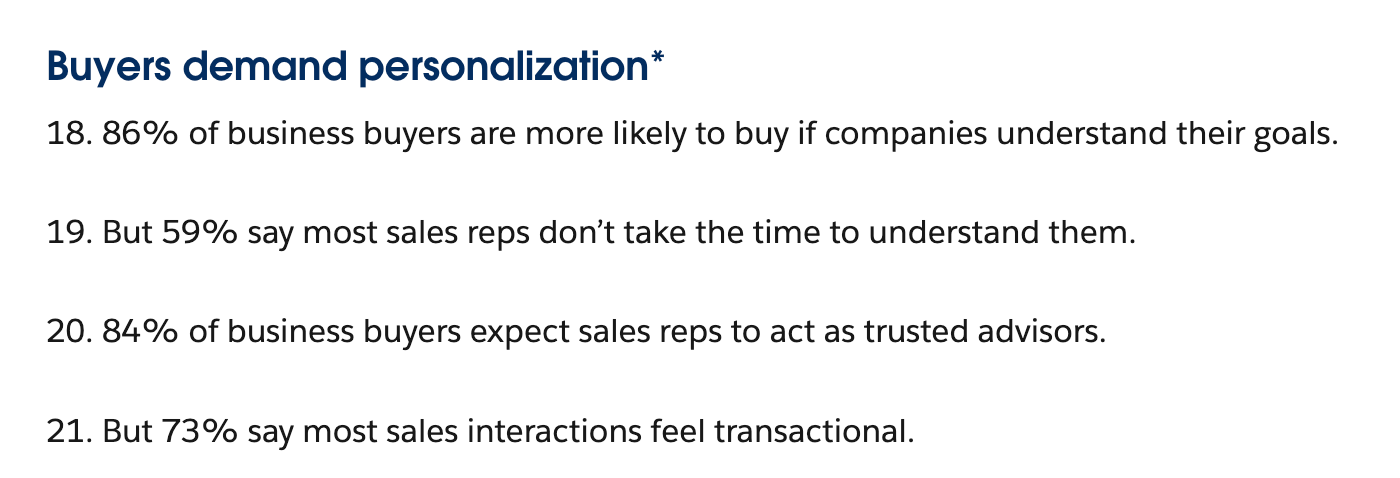Your B2B Sales Team Is Lying About Why They Can't Close Deals
The reason 59% of B2B deals stall has nothing to do with your product
The Best B2B Product Marketers Sell the ‘After’ State, Not the Product
Most B2B product marketing fails because it focuses on features and capabilities rather than the transformation.
Here’s what great product marketers understand: your buyers aren’t purchasing software, platforms, or services. They’re buying a better version of their professional reality.
The insight: The companies winning in B2B right now are those that map their entire product narrative to specific job outcomes rather than product specifications. Instead of “our platform has real-time analytics dashboards,” it’s “your CFO stops asking why the forecast was wrong.” Instead of “AI-powered workflow automation,” it’s “your team leaves at 5pm instead of 8pm.”
Why This Matters Now
Decision fatigue is real. B2B buyers evaluate 5-10 vendors per purchase. The one that helps them visualize their post-purchase life most clearly wins.
Internal selling has gotten harder. Your champion needs to sell your product to 6-8 stakeholders on average. Give them a story about transformed outcomes, not a feature list to memorize.
ROI is table stakes. Everyone can show ROI. But can you show emotional ROI? The feeling of not being the bottleneck? The credibility gained from accurate reporting?
The Messaging Hierarchy That Works
Structure your narrative like this:
First: The frustrating “before” state. Be specific. Generic pain points don’t resonate.
Second: The aspirational “after” state. Day-in-the-life details matter.
Third: The belief shift required. “This is actually possible for us.”
Finally: How your product enables this transition. Features as proof points.
Most B2B marketers invert this completely. They lead with product and hope buyers will imagine the outcome themselves. They won’t.
Why Sales Teams Default to Feature-Selling
Here’s the uncomfortable truth: most B2B salespeople focus on product features because it’s easier to talk about what’s in the deck than it is to actually listen to the sales call and understand how the product solves the real problem.
Features are comfortable. They’re scripted. They’re defensible in internal reviews.
The data backs this up: 59% of business buyers say most sales reps don’t take the time to understand them. Extu That’s not a training problem. That’s a prioritization problem.
Understanding the true problem requires active listening, pattern recognition across conversations, and the intellectual work of translating product capabilities into specific customer outcomes. That’s harder. It requires sales and product marketing to actually collaborate on translating real customer language into messaging that resonates.
The best product marketing teams record sales calls, extract the actual language prospects use to describe their pain, and build their “after state” narratives directly from those conversations. They don’t assume they know the problem. They listen until the real problem reveals itself.
Tools to Showcase the End Solution
If you’re serious about selling the transformation instead of the product, here are the tools that actually help:
Interactive ROI Calculators. Navattic, Reprise, or Arcade. But not the generic “save X hours per week” type. Build calculators that show the specific domino effect of solving the problem. If you’re selling recruitment software, don’t just show “time saved per hire.” Show how that time saved means hitting headcount targets on time, which means launching the product on schedule, which means hitting revenue goals.
Before/After Scenario Videos. Use Loom or Vidyard to create split-screen walkthroughs showing the same task in the prospect’s current state versus with your solution. Make these specific to different personas and use cases. A 90-second video showing a marketing ops manager’s actual daily workflow transformed is worth a thousand feature bullets.
Customer Story Libraries. Clari Copilot, Gong, or Chorus. These conversation intelligence tools help you mine actual sales calls for the language customers use when they describe their transformation. Build a searchable library of “after state” stories indexed by industry, company size, and use case. Your sales team should be able to pull the perfect customer transformation story in 30 seconds.
Interactive Demo Environments. Walnut, Demostack, or Tourial. Create sandbox environments that drop prospects directly into their “after” state. Let them experience what their day looks like with the problem solved. Skip the feature tour. Put them in the driver’s seat of their transformed workflow.
Value Realization Dashboards. Tools like Catalyst or ChurnZero aren’t just for customer success. Use them in pre-sales to show prospects exactly how you’ll measure their transformation. Show them the specific metrics you’ll track together to prove they’ve reached that “after” state.
The Bottom Line
The companies that win in B2B product marketing aren’t those with the best features. They’re the ones that make the transformed future feel inevitable, tangible, and within reach.
Stop selling what your product does. Start selling who your customer becomes.



